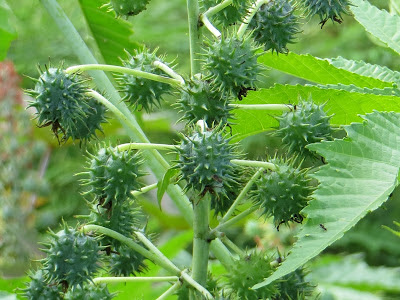Poisonous Plant: Castor Bean
The Castor Bean (Ricinus communis) is easily identified by its palmately lobed leaves with toothed margin held by a rather long stalk. It originated from parts of Africa and Middle East but now has spread to many tropical countries where it grows along rivers, roadside and disturbed places. Inside the capsular fruit, which is covered with soft bristles, are several smooth and glossy seeds or beans.
Castor Bean is most notable for its poisonous properties, due to the presence of ricin especially inside the seed. Ricin can enter the cell and block protein production, a critical process for living organisms. Eating the seeds causes stomach pain, water loss, nausea, vomiting, and in severe cases death.
 |
| Castor Bean leaves |
Castor Bean is most notable for its poisonous properties, due to the presence of ricin especially inside the seed. Ricin can enter the cell and block protein production, a critical process for living organisms. Eating the seeds causes stomach pain, water loss, nausea, vomiting, and in severe cases death.
 |
| Castor Bean fruits |
Despite its reputation as a poisonous plant, the oil extracted from this plant has many benefits. Aside from being used as lubricants, Castor oil is also used in the production of varnishes, polishes and ink. In medicine, Castor oil is an effective laxative, but one should exercise caution when using it to avoid unwanted side effects. When applied externally, it can cure excess body growth such as cysts.